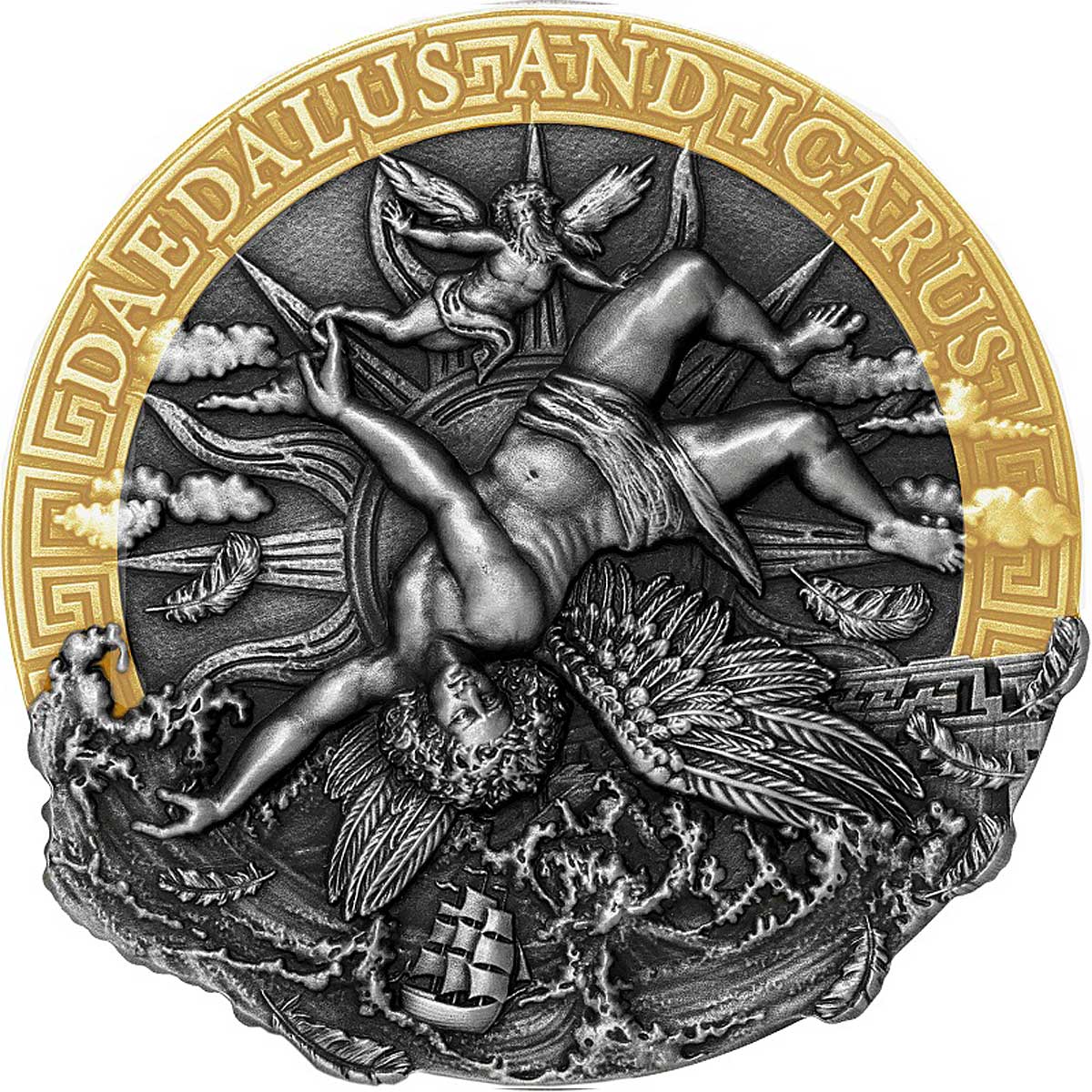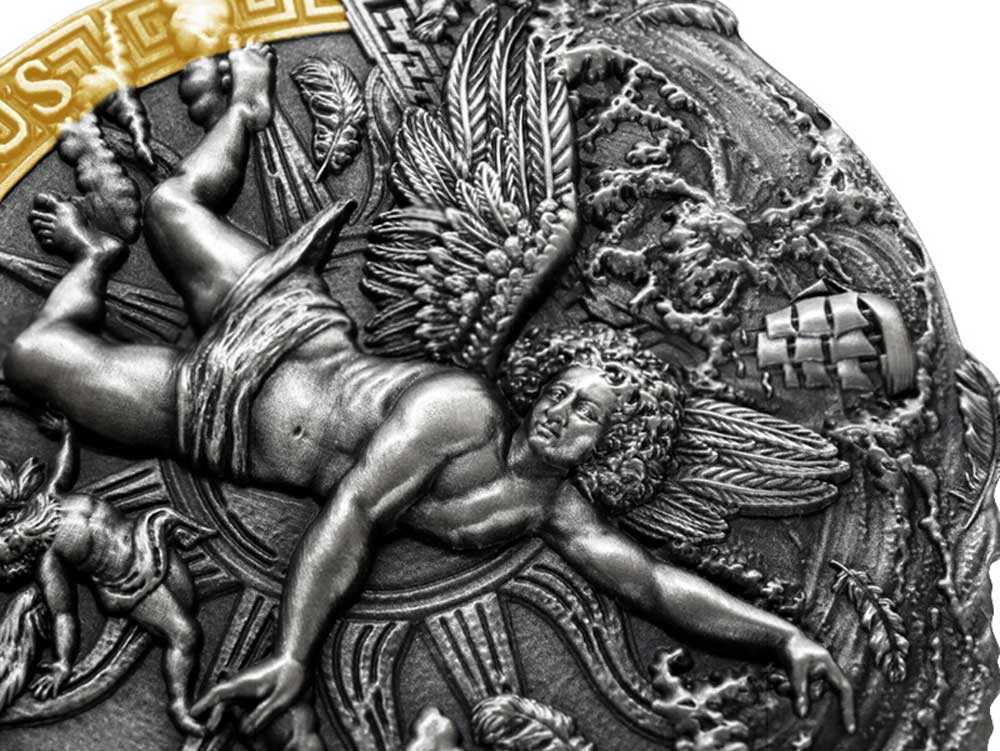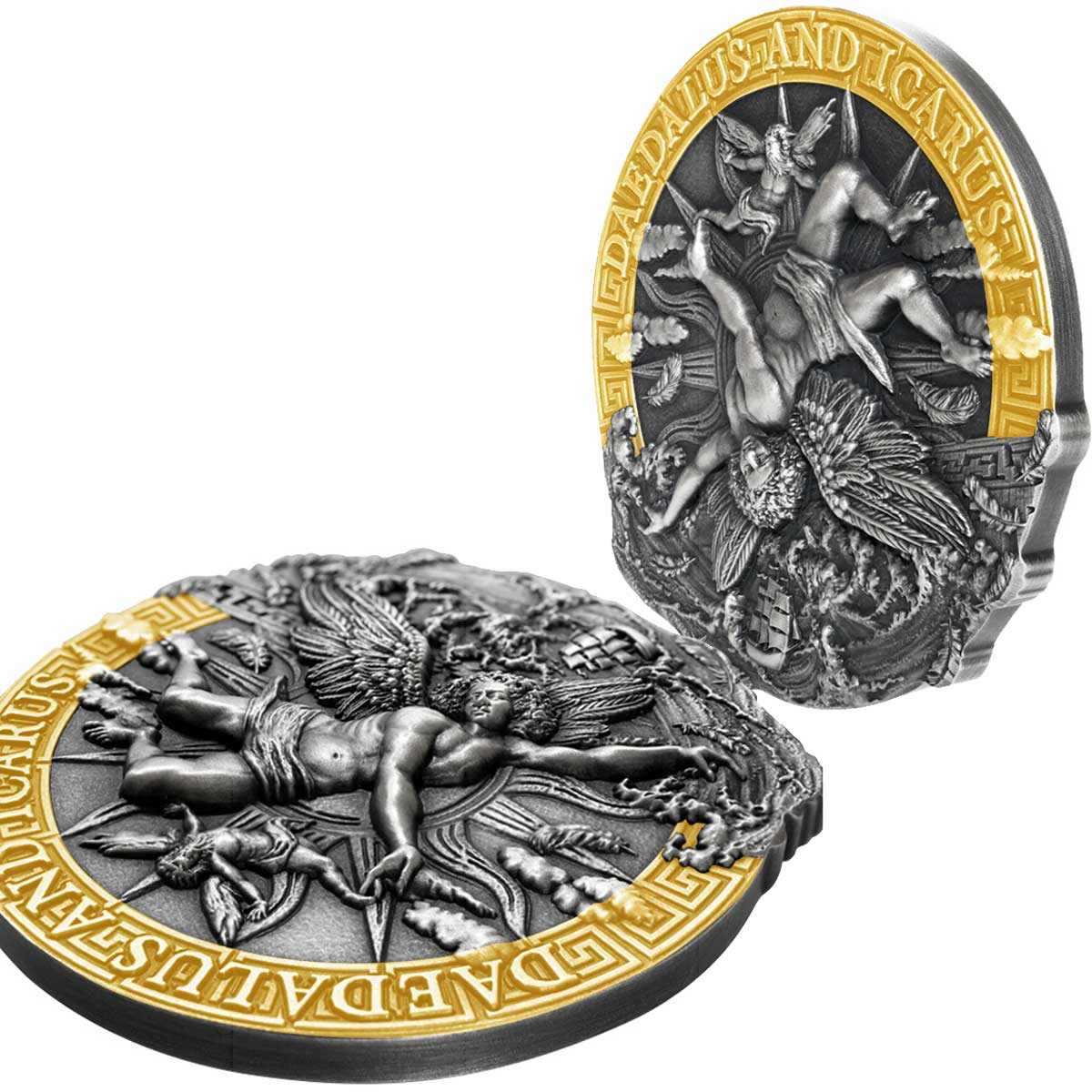The tragic story of Daedalus and Icarus inspires a striking new ultra-high relief silver coin
Mythology coins almost overwhelmingly focus on the major players, such as gods, demons and otherworldly creatures, so it’s a pleasant surprise to see a new series simply called ‘Mythology’ that focuses its attention elsewhere. Amongst the stories of gods smiting and heroes heroing, there are allegorical tales meant to warn about hubris, stupidity and greed. One of them is so famous that even to this day, at least 3,500 years later, is still used to describe someone that has over-reached at something – the tale of Icarus flying too close to the sun..
The coin will need to depict the fall of Icarus while his father looks on, after flying too close to the sun and melting the wax that held his wings on, and it does that superbly. The focal point of the coin is obviously the fine rendition of Icarus plummeting to his doom in the sea. Daedalus flies above him, while a classic image of the sun fills the background. The symbolism is clear and the tale is fully realised in a single panorama. Impressive.
The clever part comes with how the sea is integrated into the design. Choosing to eschew sticking to the boundaries of the traditional circular coin shape, it laps over the edge in an uneven way, bringing the stormy sea to full three dimensional life. We love how such a little tweak like that does so much to lift the coins overall appearance. The border area is gilded and holds the title over a Greco-Roman pattern. Just a quick note, the coin image below is a photo, but the gilded border was overlaid, no doubt because this was a prototype coin. The real thing should look even better.
The obverse is also excellent. The effigy of Queen Elizabeth II sits in the centre of a labyrinth (Daedalus had created the labyrinth on Crete that held the Minotaur), around which is a border holding the inscribed issue details. This face is also greatly enhanced by the waves overlapping from the reverse face, all done in a style somewhat reminiscent of Hokusai’s Great Wave off Kanegawa woodcut. The feathers in the water is a terrific little touch, hinting at the care and attention put into the coin.
Struck to a high-relief in two ounces of 0.999 silver, this issue is one by a rising star of the last year or two, the Mint of Gdansk, who produce the coin and have it struck by the Mint of Poland. On this evidence, it’s another series to watch. It’s available to order now, comes boxed with a Certificate of Authenticity, and will ship in January.
DAEDALUS AND ICARUS
The most familiar literary telling explaining Daedalus’ wings is a late one by Ovid in his Metamorphoses.
After Theseus and Ariadne eloped together, Daedalus and his son Icarus were imprisoned by King Minos in the labyrinth that he had built. He could not leave Crete by sea, as King Minos kept a strict watch on all vessels, permitting none to sail without being carefully searched. Since Minos controlled the land routes as well, Daedalus set to work to make wings for himself and his son Icarus. Using bird feathers of various sizes, thread, and wax, he shaped them to resemble a bird’s wings. When both were prepared for flight, Daedalus warned Icarus not to fly too high, because the heat of the sun would melt the wax, nor too low, because the sea foam would soak the feathers and make them heavy.
They had passed Samos, Delos and Lebynthos, and the boy, forgetting himself, began to soar upward toward the sun. The blazing sun melted and softened the wax that held the feathers together and they fell off one by one. Losing his wings, Icarus fell in the sea and drowned. Daedalus wept (lamenting his own arts), took Icarus’s body and buried it. He called the island near the place where Icarus fell into the ocean Icaria, in the memory of his son. The southeast end of the Aegean Sea (where Icarus fell into the water) was also called “Mare Icarium” or the Icarian Sea.
In a twist of karma, a partridge (the nephew Daedalus murdered) mocked Daedalus as he buried his son. The fall and death of Icarus is seemingly portrayed as punishment for Daedalus’s murder of his nephew. (Source: Wikipedia)
| SPECIFICATION | |
| DENOMINATION | $5 NZD (Niue) |
| COMPOSITION | 0.999 silver |
| WEIGHT | 62.2 grams |
| DIMENSIONS | 45.0 mm |
| FINISH | Antique |
| MODIFICATIONS | Ultra high-relief, gilding |
| MINTAGE | 500 |
| BOX / C.O.A. | Yes / Yes |








Omg, beautiful coin! I love mythology!
I need this in my collection!
It is a pity that the name of the coin is also gilded. But anyway it’s a nice coin, ordered, looking forward to it 😀